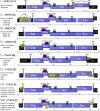Identification of diverse full-length endogenous betaretroviruses in megabats and microbats
- PMID: 23537098
- PMCID: PMC3621094
- DOI: 10.1186/1742-4690-10-35
Identification of diverse full-length endogenous betaretroviruses in megabats and microbats
Abstract
Background: Betaretroviruses infect a wide range of species including primates, rodents, ruminants, and marsupials. They exist in both endogenous and exogenous forms and are implicated in animal diseases such as lung cancer in sheep, and in human disease, with members of the human endogenous retrovirus-K (HERV-K) group of endogenous betaretroviruses (βERVs) associated with human cancers and autoimmune diseases. To improve our understanding of betaretroviruses in an evolutionarily distinct host species, we characterized βERVs present in the genomes and transcriptomes of mega- and microbats, which are an important reservoir of emerging viruses.
Results: A diverse range of full-length βERVs were discovered in mega- and microbat genomes and transcriptomes including the first identified intact endogenous retrovirus in a bat. Our analysis revealed that the genus Betaretrovirus can be divided into eight distinct sub-groups with evidence of cross-species transmission. Betaretroviruses are revealed to be a complex retrovirus group, within which one sub-group has evolved from complex to simple genomic organization through the acquisition of an env gene from the genus Gammaretrovirus. Molecular dating suggests that bats have contended with betaretroviral infections for over 30 million years.
Conclusions: Our study reveals that a diverse range of betaretroviruses have circulated in bats for most of their evolutionary history, and cluster with extant betaretroviruses of divergent mammalian lineages suggesting that their distribution may be largely unrestricted by host species barriers. The presence of βERVs with the ability to transcribe active viral elements in a major animal reservoir for viral pathogens has potential implications for public health.
Figures





Similar articles
-
A novel endogenous betaretrovirus in the common vampire bat (Desmodus rotundus) suggests multiple independent infection and cross-species transmission events.J Virol. 2015 May;89(9):5180-4. doi: 10.1128/JVI.03452-14. Epub 2015 Feb 25. J Virol. 2015. PMID: 25717107 Free PMC article.
-
Identification of diverse groups of endogenous gammaretroviruses in mega- and microbats.J Gen Virol. 2012 Sep;93(Pt 9):2037-2045. doi: 10.1099/vir.0.043760-0. Epub 2012 Jun 13. J Gen Virol. 2012. PMID: 22694899 Free PMC article.
-
Identification of novel endogenous betaretroviruses which are transcribed in the bovine placenta.J Virol. 2011 Feb;85(3):1237-45. doi: 10.1128/JVI.01234-10. Epub 2010 Nov 17. J Virol. 2011. PMID: 21084469 Free PMC article.
-
Endogenous betaretroviruses of sheep: teaching new lessons in retroviral interference and adaptation.J Gen Virol. 2004 Jan;85(Pt 1):1-13. doi: 10.1099/vir.0.19547-0. J Gen Virol. 2004. PMID: 14718613 Review.
-
Endogenous retroviruses related to jaagsiekte sheep retrovirus.Curr Top Microbiol Immunol. 2003;275:117-37. doi: 10.1007/978-3-642-55638-8_5. Curr Top Microbiol Immunol. 2003. PMID: 12596897 Review.
Cited by
-
Genome-wide characterization of endogenous retroviruses in the bat Myotis lucifugus reveals recent and diverse infections.J Virol. 2013 Aug;87(15):8493-501. doi: 10.1128/JVI.00892-13. Epub 2013 May 29. J Virol. 2013. PMID: 23720713 Free PMC article.
-
A novel endogenous betaretrovirus group characterized from polar bears (Ursus maritimus) and giant pandas (Ailuropoda melanoleuca).Virology. 2013 Aug 15;443(1):1-10. doi: 10.1016/j.virol.2013.05.008. Epub 2013 May 29. Virology. 2013. PMID: 23725819 Free PMC article.
-
Biologically inspired intelligent decision making: a commentary on the use of artificial neural networks in bioinformatics.Bioengineered. 2014 Mar-Apr;5(2):80-95. doi: 10.4161/bioe.26997. Epub 2013 Dec 16. Bioengineered. 2014. PMID: 24335433 Free PMC article. Review.
-
Hologenomic adaptations underlying the evolution of sanguivory in the common vampire bat.Nat Ecol Evol. 2018 Apr;2(4):659-668. doi: 10.1038/s41559-018-0476-8. Epub 2018 Feb 19. Nat Ecol Evol. 2018. PMID: 29459707 Free PMC article.
-
GALV-KoRV-related retroviruses in diverse Australian and African rodent species.Virus Evol. 2024 Jul 31;10(1):veae061. doi: 10.1093/ve/veae061. eCollection 2024. Virus Evol. 2024. PMID: 39175839 Free PMC article.
References
-
- Vogt VM. In: Retroviruses. Coffin JM, Hughes SH, Varmus HE, editor. New York, USA: Cold Spring Harbor Laboratory Press; 1997. Historical introduction to the general properties of retroviruses. - PubMed
-
- Stoye JP. Studies of endogenous retroviruses reveal a continuing evolutionary saga. Nat Rev Micro. 2012;10:395–406. - PubMed
-
- Kurth R, Bannert N. Retroviruses. Berlin: Caister Academic Press; 2010.
-
- Vogt VM. In: Retroviruses. Coffin JM, Hughes SH, Varmus HE, editor. New York, USA: Cold Spring Harbor Laboratory Press; 1997. Retroviral virions and genomes. - PubMed
Publication types
MeSH terms
Substances
LinkOut - more resources
Full Text Sources
Other Literature Sources

